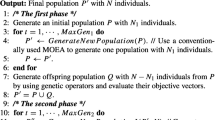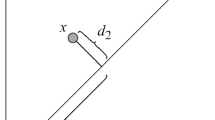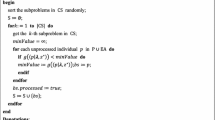Abstract
Multi-objective optimization problems (MOPs) are very common in practice. To solve MOPs, many kinds of multi-objective evolutionary algorithms (MOEAs) are proposed. However, different MOEAs have different performances for different MOPs. Therefore, it is a time-consuming task to choose a suitable MOEA for a given problem. To pursue a competitive performance for various kinds of MOPs, in this paper, we propose a framework named hyper multi-objective evolutionary algorithm (HMOEA). In this framework, more than one MOEAs are employed, which is more adaptive to different problems. In HMOEA, the population will be randomly divided into several groups. In each group, a selected MOEA will be implemented. Therefore in the framework, the number of groups is equal to the number of the employed MOEAs. The size of each group, namely the size of sub-population in each group, is adjusted according to the corresponding MOEA’s performance. If a MOEA performs well, its corresponding group will have a large size group, which means the MOEA obtains more computational resources. On the contrary, if a MOEA has a poor performance in current generation, its corresponding group will obtain only a few individuals. Although a MOEA does not perform very well in current generation, the framework will not abandon this MOEA, but provide it a group that has predefined small size. The reason is that an involvement of different MOEAs will increase the diversity of algorithms in the hyper framework, which is helpful for HMOEA to avoid local optima and also can help HMOEA be adaptive to different phases in the whole optimization process. To compare MOEAs’ performances, coverage rate (CR) metric is used to evaluate the quality of MOEA and therefore decides the size of group for each MOEA. In numerical experiments, ZDT benchmarks are employed to test the proposed hyper framework. Several classic MOEAs are also used in comparisons. According to the comparison results, HMOEA can achieve very competitive performances, which demonstrates that the design is feasible and effective to solve MOPs.






Similar content being viewed by others
References
Aggelogiannaki E, Sarimveis H (2007) A simulated annealing algorithm for prioritized multi-objective optimization implementation in an adaptive model predictive control configuration. IEEE Trans Syst Man Cybern Part B 37(4):902–915
Agrawal G, Kawajiri Y (2012) Comparison of various ternary simulated moving bed separation schemes by multi-objective optimization. J Chromatogr 1238:105–113
Ahmadi P, Almasi A, Shahriyari M, Dincer I (2012) Multi-objective optimization of a combined heat and power (CHP) system for heating purpose in a paper mill using evolutionary algorithm. Int J Energy Res 36(1):46–63
Asadzadeh M, Tolson B (2013) Pareto archived dynamically dimensioned search with hyper volume-based selection for multi-objective optimization. Eng Optim 45(12):1489–1509
Attea BA, Khali EA, Cosar A (2015) Multiobjective evolutionary routing protocol for efficient coverage in mobile sensor network. Soft Comput 19(10):2983–2995
Chang J, Shi P (2011) Using investment satisfaction capability index based particle swarm optimization to construct a stock portfolio. Inf Sci 181(14):2989–2999
Chiandussi G, Codegone M, Ferrero S et al (2012) Comparison of multi-objective optimization methodologies for engineering applications. Comput Math Appl 63(5):912–942
Chen BJ, Shu HZ, Coatrieux G, Chen G, Xun XM, Coatrieux JL (2015) Color image analysis by quaternion-type moments. J Math Imaging Vis 51:124–144
Deb K (1999) Multi-objective genetic algorithm: problem difficulties and construction of test problems. Evol Comput 7:205–230
Deb K, Pratap A, Agarwal S, Meyarivan T (2000) A fast elitist multi-objective genetic algorithm: NSGA-II. IEEE Trans Evol Comput 6(2):182–197
Farmani R, Savic DA, Walters GA (2005) Evolutionary multi objective optimization in water distribution network design. Eng Optim 37(2):167–183
Fu ZJ, Sun XM, Liu Q, Zhou L, Shu JG (2015) Achieving efficient cloud search services: multi-keyword ranked search over encrypted cloud date supporting parallel computing. IEICE Trans Commun E98B(1):190–200
Garcia J, Florez JE, Torralba A, Borrajo D, Lopez CL, Garcia-Olaya A, Saenz J (2013) Combining linear programming and automated planning to solve intermodal transportation problems. Eur J Oper Res 227(1):216–226
Gong M, Jiao L, Du H, Bo L (2008) Multiobjective immune algorithm with nondominated neighbor-based selection. Evol Comput 16(2):225–255
Guo W, Wang L, Ge SS, Ren H, Mao Y (2015) Drift analysis of mutation operations for biogeography-based optimization. Soft Comput 19:1881–1892
Guo W, Wang L, Wu Q (2016) Numerical comparisons of migration models for multi-objective biogeography based optimization. Inf Sci 328:302–320
Horn J, Horn J, Nafpliotis N, Nafpliotis N, Goldberg DE (1993) Multi-objective optimization using the niched pareto genetic algorithm. Technical report
Jararweh Y, Al-Ayyoub M, Darabseh A, Benkhelifa E, Vouk M, Rindos A (2016) Software defined cloud: survey, system and evaluation. Future Gener Comput Syst Int J Escience 56:56–74
Li J, Li XL, Sun XM (2015) Segmentation-based image copy-move forgery detection scheme. IEEE Trans Inf Forensics Secur 10(3):507–518
Ma TH, Zhou JJ, Tang ML, Tian Y, AL-Dhelaan A, AL-Rodhaan M, Lee S, (2015) Social network and tag sources based augmenting collaborative recommender system. IEICE Trans Inf Syst 98 (4):902–910
Pan ZQ, Zhang Y, Kwong S (2015) Efficient motion and disparity estimation optimization for low complexity multiview video coding. IEEE Trans Broadcast 61(2):166–176
Rahimi-Vahed A, Mirghorbani SM, Rabbani M (2007) A new particle swarm algorithm for a multi-objective mixed-model assembly line sequencing problem. Soft Comput 11(10):997–1012
Sarker R, Abbass HA (2004) Differential evolution for solving multi-objective optimization problems. Asia Pac J Oper Res 21(2):225–240
Schaffer JD(1984) Some experiments in machine learning using vector evaluated genetic algorithms. PhD thesis, Nashville, Vanderbilt University
Shen J, Tan HW, Wang J, Wang JW, Lee S, (2015) A novel routing protocol providing good transmission reliability in underwater sensor networks. J Internet Technol 16(1):171–178
Simon D (2008) Biogeography-based optimization. IEEE Trans Evol Comput 12(6):702–713
Srinivas N, Deb K (1994) Multiobjective optimization using nondominated sorting in genetic algorithms. Evol Comput 2:221–248
Suresh S, Sujit PB, Rao AK (2007) Particle swarm optimization approach for multi-objective composite box-beam design. Compos Struct 81(4):598–605
Tan KC, Lee TH, Khor EF (2002) Evolutionary algorithms for multi-objective optimization: performance assessments and comparisons. Artif Intell Rev 17(4):253–290
Veldhuizen DAV (1998) Multiobjective evolutionary algorithm research: a history and analysis. Technical report, Department of Electrical and Computer Engineering, Graduate School of Engineering, Air Force Institute of Technology, Wright-Patterson AFB, OH
Wang WM, Zmeureanu R, Rivard H (2005) Applying multi-objective genetic algorithms in green building design optimization. Build Environ 40(11):1512–1525
Wang L, Singh C (2007) Environmental/economic power dispatch using a fuzzied multi-objective particle swarm optimization algorithm. Electr Power Syst 77(12):1654–1664
Wen XZ, Shao L, Xue Y, Fang W (2015) A rapid leanring algorithm for vehicle classification. Inf Sci 295:395–406
Wolpert DH, Macready WG (1997) No free lunch theorems for optimization. IEEE Trans Evol Comput 1(1):67–82
**a ZH, Wang XH, Sun XM, Wang Q (2016) A secure and dynamic multi-keyword ranked search scheme over encrypted cloud data. IEEE Trans Parallel Distrib Syst 27(2):340–352
**e SD, Wang YX (2014) Construction of tree network with limited delivery latency in homogeneous wireless sensor networks. Wirel Pers Commun 78:231–246
Yen GG, He Z (2014) Performance metric ensemble for multi-objective evolutionary algorithms. IEEE Trans Evol Comput 18(1):131–144
Zhang G, Shao X, Li P (2009) An effective hybrid particle swarm optimization algorithm for multi-objective flexible jobshop scheduling problem. Comput Ind Eng 56(4):1309–1318
Zhang Q, Li H (2007) MOEA/D: a multi-objective evolutionary algorithm based on decomposition. IEEE Trans Evol Comput 11(6):712–731
Zheng Y, Jeon B, Xu DH, Wu JQM, Zhang H (2015) Image segmentation by generalized hierarchical fuzzy C-means algorithm. J Intell Fuzzy Syst 28:961–973
Zitzler E, Deb K, Thiele L (2000) Comparison of multi-objective evolutionary algorithms: empirical results. Evol Comput 8(2):173–195
Zitzler E, Thiele L (1999) Multi-objective evolutionary algorithms: a comparative case study and the strength pareto approach. IEEE Trans Evol Comput 3(4):257–271
Acknowledgments
This work is sponsored by the National Natural Science Foundation of China under Grant No. 61503287 and No. 61203250, the Fundamental Research Funds for the Central Universities (Young Talents Program in Tongji University), A Project Funded by the Priority Academic Program Development of Jiangsu Higher Education Institutions, Jiangsu Collaborative Innovation Center on Atmospheric Environment and Equipment Technology.
Author information
Authors and Affiliations
Corresponding author
Ethics declarations
Conflict of interest
The authors declared that they have no conflicts of interest to this work. We declare that we do not have any commercial or associative interest that represents a conflict of interest in connection with the work submitted.
Additional information
Communicated by Y. **.
Rights and permissions
About this article
Cite this article
Guo, W., Chen, M., Wang, L. et al. Hyper multi-objective evolutionary algorithm for multi-objective optimization problems. Soft Comput 21, 5883–5891 (2017). https://doi.org/10.1007/s00500-016-2163-5
Published:
Issue Date:
DOI: https://doi.org/10.1007/s00500-016-2163-5




